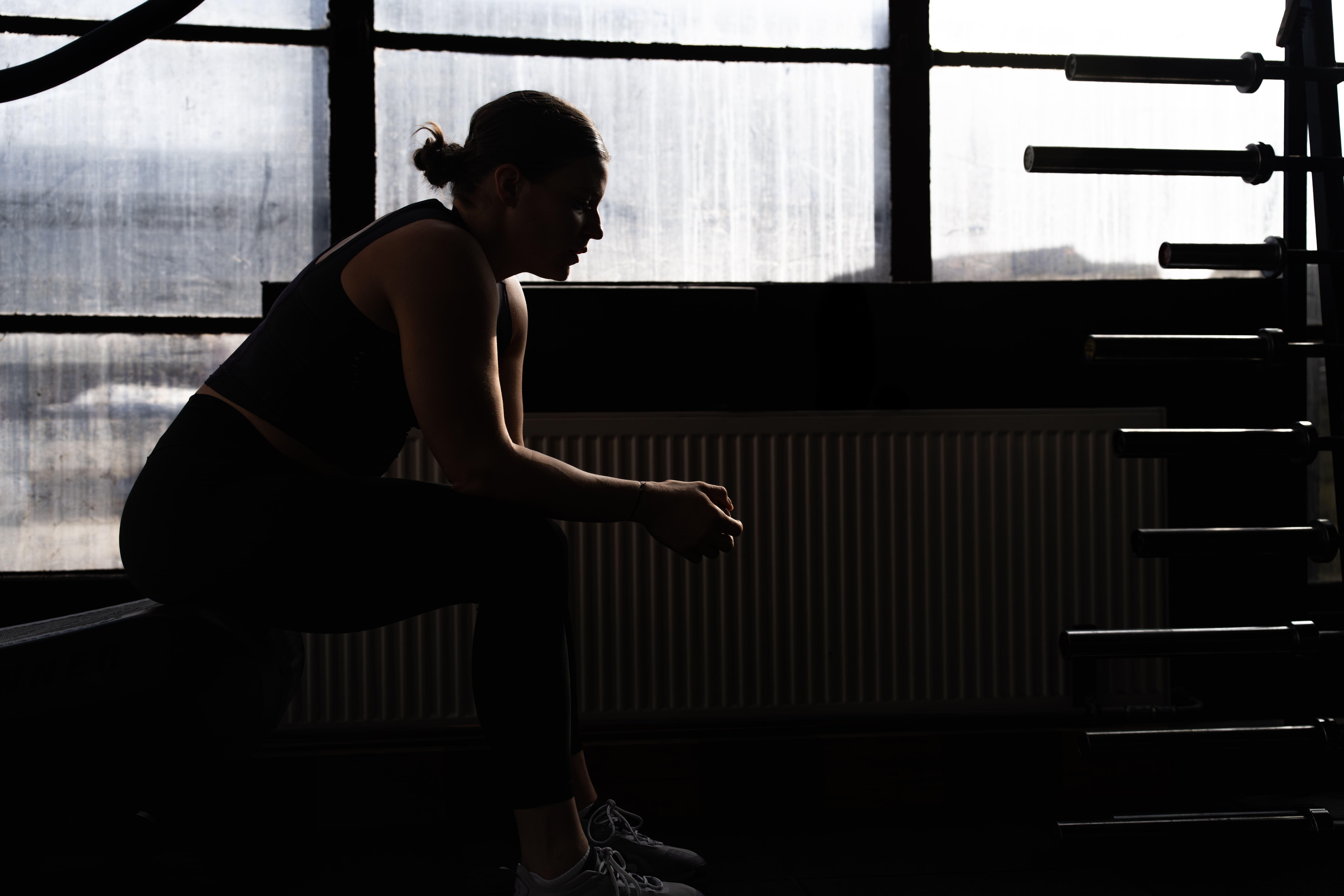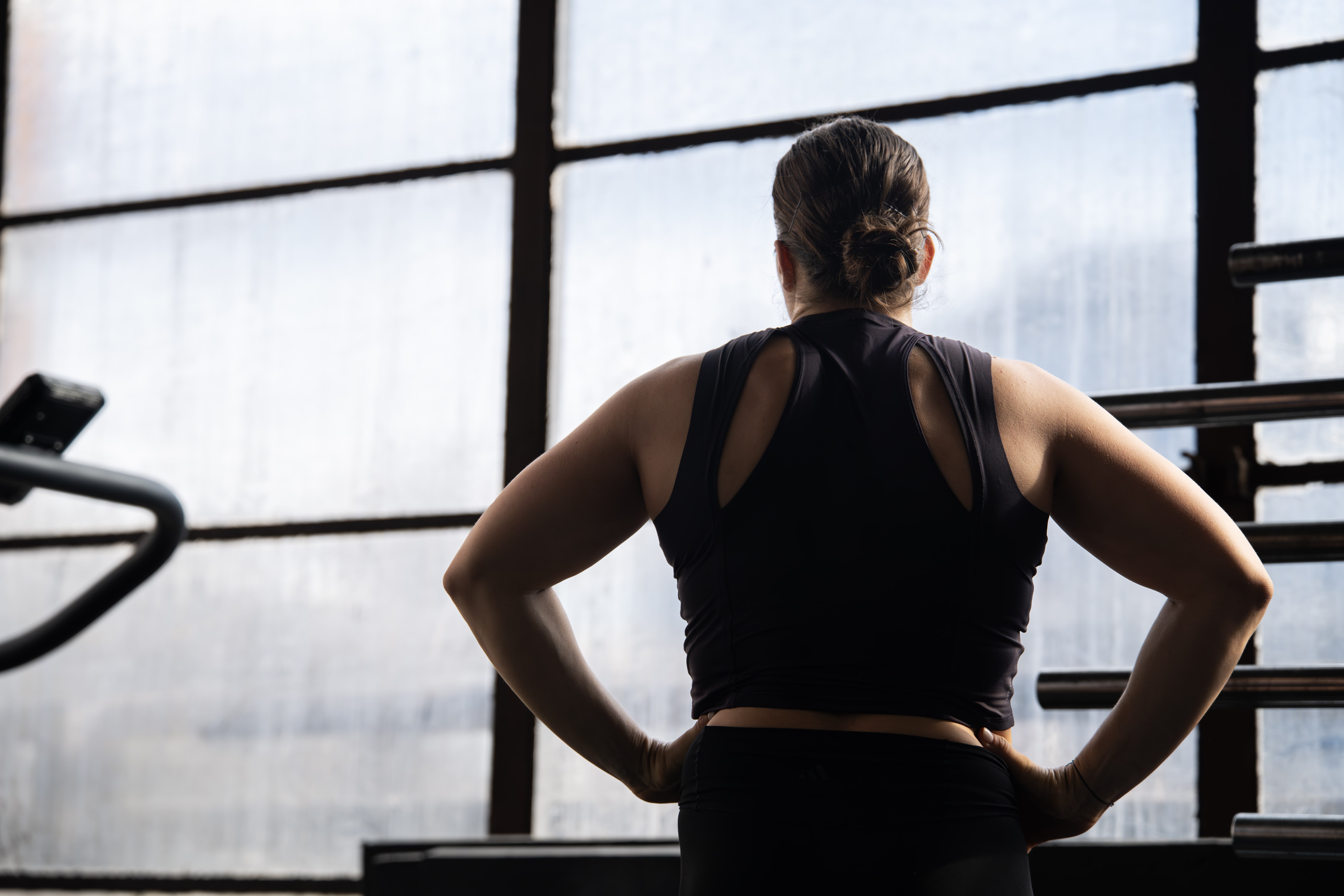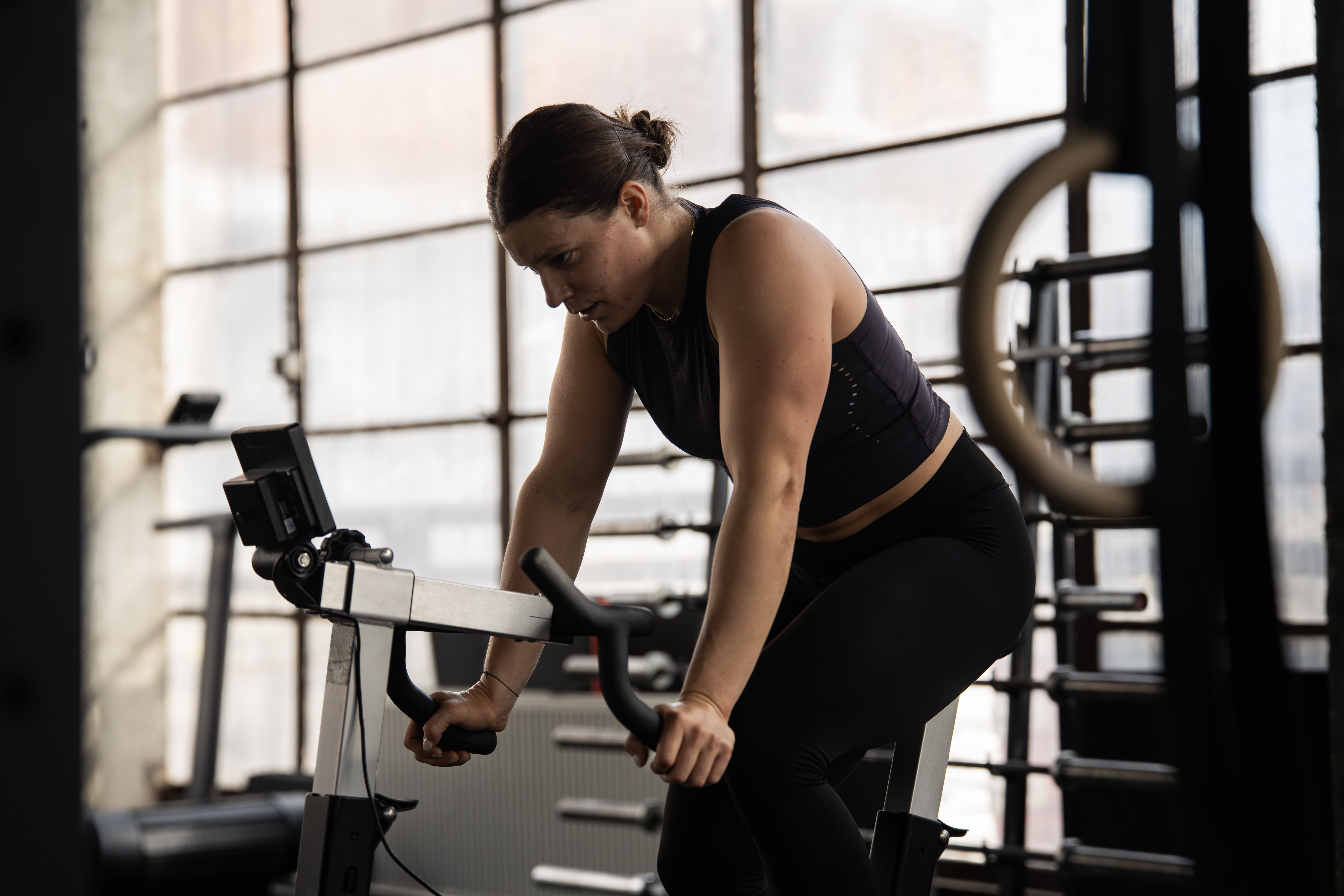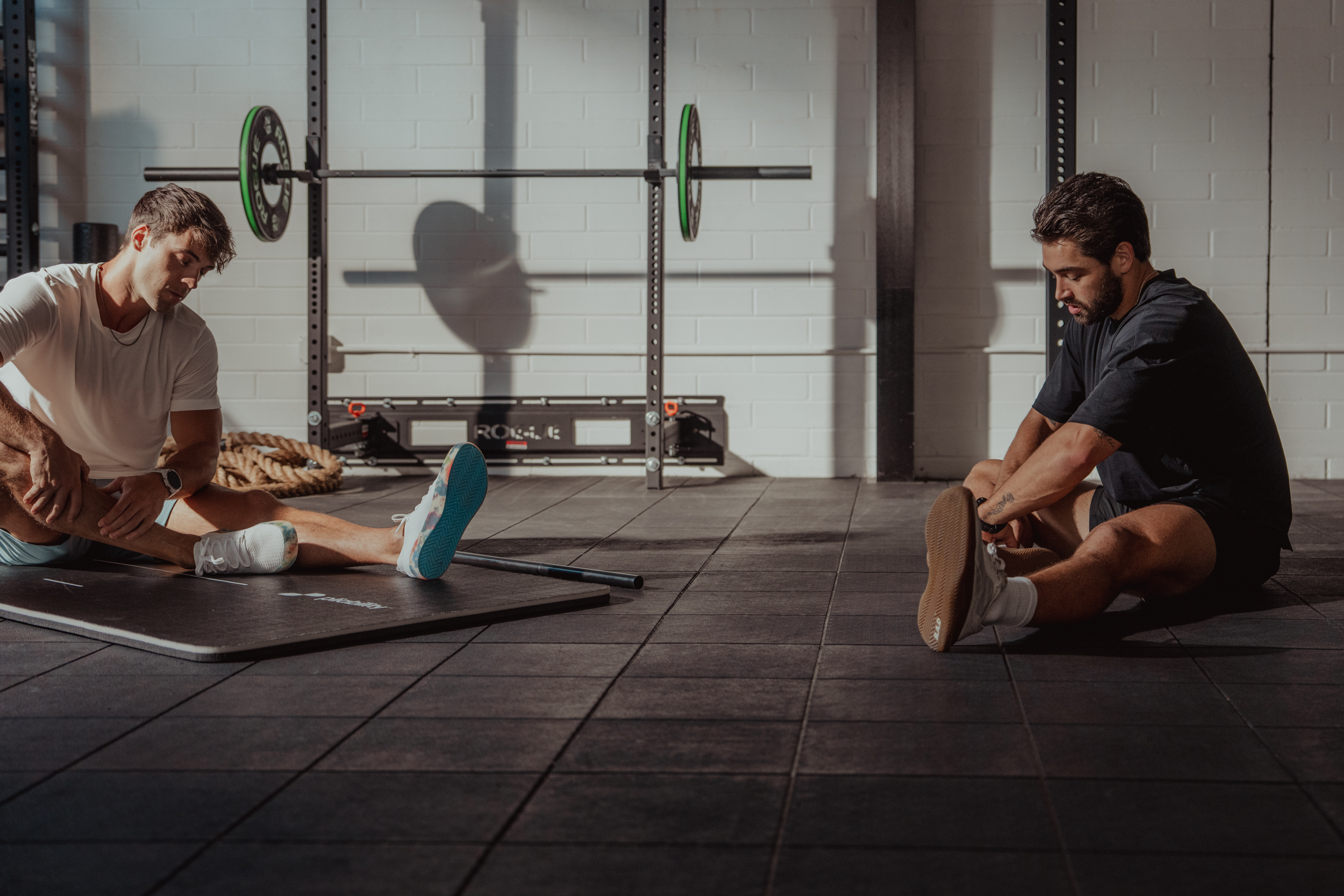Hyrox races present a unique challenge for nearly every athlete, regardless of their fitness level or training background. That’s because Hyrox events combine running with eight functional workouts in a race format that tests both your endurance and strength. The workouts, known as Hyrox exercises, reward well-rounded athletes who can tackle both the running and functional portions of the race with confidence. In this guide, we’ll cover everything you need to know about the eight Hyrox exercises, including how to train effectively for them so you can complete the race stronger, faster, and with greater confidence.
Pliability’s mobility app can help you achieve your goals by providing valuable insights and targeted routines to improve your flexibility and recovery as you prepare for your Hyrox event.
What Exactly Is Hyrox? Breaking Down the Basics of the Endurance Competition

HYROX is an endurance competition designed to challenge even the most seasoned hybrid athletes. This race is held in cities worldwide throughout the year, making it accessible to a global audience of fitness enthusiasts. The format is straightforward yet grueling: one kilometer of running followed by one workout, repeated eight times.
This means participants must complete a total of eight kilometers of running (about five miles) and eight functional exercises in the designated order, either alone or in a team of two or four.
What Makes HYROX Workouts Unique
The workouts include a mix of cardio and strength exercises, such as sled pushes, burpee broad jumps, and sandbag walking lunges, among others. While it’s often compared to CrossFit, HYROX is typically less technical, focusing on functional exercises that require less skill but plenty of cardiovascular and muscular endurance.
Who Can Compete? Exploring the Hyrox Community
What I love about HYROX is that there's a way to compete that suits you, no matter your fitness level or experience. Whether you're a high-level athlete wanting to crush the race solo or just looking to dip your toes into competition alongside friends, there's a way for most people to do it.
There are four main divisions:
- Individual Pro: Heavier weights for elite solo athletes
- Individual Open: The standard solo challenge, with lighter weights
- Doubles: Partner up and split up the workouts while running all 1ks together
- Team relay: Divvy up all runs and exercises among four people for the most accessible HYROX experience
This range of options opens the race up to participants of all ages and fitness levels. Although thoughtful training and preparation are essential to compete safely in any division, HYROX is truly a race for everyone, and the sense of inclusivity is palpable.
How Popular is Hyrox Racing?
Rapidly growing in popularity, HYROX has become a truly global phenomenon, with half a million athletes expected to compete worldwide during the 2024-25 season.
Tips for Competing in Hyrox
Whether you’re gearing up for your first Hyrox or trying to shave a few minutes off your last PB, don’t let the sleds and ski-ergs distract you from the real challenge.
“Hyrox is a running race,” says coach and athlete Liam Hatch. “Yes, there are eight workouts between each run, but trust me, your running engine is what gets you through.”
Related Reading
What Are the 8 Hyrox Exercises?

1. Skiing Without Snow: The Skeerg
After completing your initial 1 km run, the SkiErg is the first station you encounter. The requirement here is to cover a total of 1km on the Concept2 SkiErg machine. Competitors pull the handles of the SkiErg downward, mimicking the motion of ski poles. It's a steady, controlled movement, requiring rhythm, endurance, and good technique to keep a strong pace without burning out early on in the race.
While it's easy to look at this and assume it's a workout primarily for the arms and shoulders, when completed efficiently, it becomes a full-body workout that also engages the core and lower body muscles.
Distance: 1,000 metres
2. Pushing an Elite Car: The Sled Push
Following your second 1km run, it's on to the sled push. One of the most physically demanding stations, the sled push, tests your leg strength and full-body power. Participants push a weighted sled down a track, using leg drive and core engagement, to cover a total distance of 50 metres. This station can often catch athletes off guard, especially if they don't pace themselves sensibly.
It's easy to tire your legs out here very early on in the race and make the remainder of the event a considerable struggle. The run immediately after this station can also be difficult for some athletes who aren't accustomed to it, especially on tired, heavy legs. A mistake I made in my first race was not taking enough short pauses during the push.
Why Sled Pushes Feel Different on Race Day
Although my time on the station itself was relatively brief, I struggled to run afterwards. When training for this station, if you haven't done a HYROX before, it's difficult to know how it will genuinely feel on race day. This is because the sled you're using, the surface you're pushing on, the humidity in the room, and other factors can all affect how well the sled moves. You can't assume that a 152kg sled weight in your gym will feel the same as on race day.
Sled Push Standards by Division
- Distance: 50 metres (4 x 12.5-metre pushes)
- Weights:
- Men's Pro / Men's Pro Doubles: 202 kg
- Women's Pro / Women’s Pro Doubles / Men's Open / Men’s Open Doubles / Mixed Open Doubles / Men’s Relay: 152 kg
- Women's Open / Women’s Open Doubles / Women’s Relay: 102 kg
- Mixed Relay: 102 kg for Women and 152 kg for Men
3. Pulling a Weighted Slwd: The Sled Pull
After your 3rd 1km run, it's on to the sled pull, another test of strength. Competitors drag the sled backwards using a rope for a total of 50 metres. At the end of each lane, you have a small box in which you can work, which is approximately 1.7 metres in depth.
This means that, rather than the sled pull being purely an upper-body exercise, you do have a small amount of space you can step back into to help move the sled. Therefore, it's an exercise that tests the posterior chain:
- Back
- Glutes
- Hamstrings
Mastering Sled Pull Technique and Safety
One element to be careful of on this station is technique and rope management. The further you pull the sled, the more rope starts to build up around your feet, which becomes easy to trip over if you aren't careful. Both the sled and the participant must be behind the line when you start this station.
You then pull the sled the length of your lane (which is 12.5 metres in length), past the line, walk back to the other end of your lane, and pull the sled back. You then need to repeat this process to make up the 50 metres. Resting at any point is fine if you need to. You will receive a penalty if you step outside of your designated area at the end of your lane.
Sled Pull Standards by Division
- Distance: 50 metres (4 x 12.5-metre pulls)
- Weights:
- Men's Pro / Men's Pro Doubles: 153 kg
- Women's Pro / Women’s Pro Doubles / Men's Open / Men’s Open Doubles / Mixed Open Doubles / Men’s Relay: 103 kg
- Women's Open / Women’s Open Doubles / Women’s Relay: 78 kg
- Mixed Relay: 78 kg for Women and 103 kg for men
4. Burpee Broad Jumps: A Leg Killer
Run 4 is followed by 80 metres of burpee broad jumps (BBJ). Combining two brutal movements, burpees and broad jumps, this station challenges cardiovascular endurance and leg explosiveness.
- You must start with your hands placed behind the line and your chest touching the floor.
- You then step or jump up, ensuring your feet don't pass your hands, and perform a broad jump (providing you take off and land with parallel feet, no staggered take-offs are allowed).
- You then drop, placing your hands no further than one length in front of your feet and your chest to the floor.
This cycle repeats until the distance is covered. It can be a brutally tough station, which, if possible, you should look to maintain an efficient, steady rhythm throughout (easier said than done!).
Distance: 80 metres
5. Rowing: An Opportunity to Catch Your Breath
After your 5th 1km run, you finally get a chance to sit down! There's no rest to be had as you must cover a total of 1km on the Concept 2 rowing machine. The rowing machine offers a comprehensive full-body cardiovascular workout that challenges both endurance and muscular stamina. A good, efficient technique can be very critical here and is something that many athletes get wrong (which costs them time and energy).
Appropriate pacing is important throughout HYROX, but especially so on this station. What you put into the rower doesn't always pay you back with a significantly faster time. For example, if I row too fast, I may finish the station, say, 10 seconds quicker, but cause myself a huge amount of fatigue for the remainder of the race.
Distance: 1,000 metres
6. Farmer’s Carry: A Grip and Core Stregth Test
The farmer's carry is the 6th station in HYROX. Participants carry two heavy kettlebells, one in each hand, while walking/running as fast as possible to cover a distance of 200 metres. You are allowed to place the kettlebells down on the floor as often as needed, but if you can complete the whole thing unbroken, it will likely mean you save time.
It's a station that tests grip strength, shoulder stability, and core endurance, and is generally one of the quickest stations in the race.
Farmer’s Carry Standards by Division
- Distance: 200 metres
- Weights:
- Men's Pro / Men's Pro Doubles: 32 kg per hand
- Women's Pro / Women’s Pro Doubles / Men's Open / Men’s Open Doubles / Mixed Open Doubles / Men’s Relay: 24 kg per hand
- Women's Open / Women’s Open Doubles / Women’s Relay: 16 per hand
- Mixed Relay: 16 kg for Women and 24 kg for Men
7. Sand Bag Lunges: The Penultimate Station
The penultimate station is the sandbag lunges. The end of the race is approaching, but you’re likely extremely fatigued at this point and must now face 100 metres of walking lunges with a weighted sandbag on your back!
Athletes' knees must touch the floor with every rep. It very much tests the quads and glutes, but there is also an element of strain on the arms and shoulders as you aren’t allowed to place the sandbag down on the floor at any point.
Sandbag Lunges Standards by Division
- Distance: 100 metres
- Weights:
- Men's Pro / Men's Pro Doubles: 30 kg
- Women's Pro / Women’s Pro Doubles / Men's Open / Men’s Open Doubles / Mixed Open Doubles / Men’s Relay: 20 kg
- Women's Open / Women’s Open Doubles / Women’s Relay: 10 kg
- Mixed Relay: 10 kg for Women and 20 kg for men
8. Wall Balls: A Mental Challenge
Nearly there! The final station is the wall balls. Here, competitors must squat down with the ball, then explode up, throwing the ball to hit a target for a total of 100 reps. After the ball is caught, the motion is repeated.
The height of the target and the weight of the ball differ depending on gender and division. Proper squat form/depth and accuracy with the ball throw (to the centre of the target) are crucial here as judges will ‘no rep’ if necessary, which results in not just added time but also added fatigue.
It is a station that tests not just your physical abilities (challenging the legs, shoulders, and cardiovascular system all at once) but also your mental strength and concentration.
Wall Balls Standards by Division
- Repetitions: 100 wall balls
- Weights:
- Men's Pro / Men's Pro Doubles: 9kg ball, 10 ft / 3.048 m target
- Women's Pro / Women’s Pro Doubles / Men's Open / Men’s Open Doubles / Mixed Open Doubles / Men’s Relay: 6 kg ball, 9 ft / 2.743 m target
- Women's Open / Women’s Open Doubles / Women’s Relay: 4 kg ball, 9 ft / 2.743 m target
- Mixed Relay: 4 kg for Women and 6 kg for men
9. Roxzone: Navigating the Transition Area
Yes, I know I said there were eight stations, but think of this as your bonus round.
There’s also the Roxzone to consider: a crucial part of the race that often gets overlooked. This is the transition area between the running segments and the workout stations. While its layout can vary by event, you’ll typically cover around 700 metres within the Roxzone throughout the race.
That’s a significant distance, and it matters. If you slow down more than necessary or waste time figuring out where to go next, you’ll lose precious seconds. Ideally, you want to maintain your running pace and move through transitions with purpose.
Training for Efficiency Under Fatigue
Each HYROX station challenges different muscle groups and tests your:
- Strength
- Endurance
- Mental grit
But success in HYROX isn’t just about mastering each station; it’s about executing them efficiently under fatigue. By training for each movement with intention, you’ll build the well-rounded fitness needed to thrive on race day (and enjoy the process, too).
Related Reading
Overall Strategies for a Successful Hyrox

Cardiovascular training is vital to preparing for Hyrox, allowing you to maintain a steady pace throughout the 8 km race and exercise stations. To prepare for the Hyrox race, combine long-distance runs with high-intensity interval training sessions.
HIIT, or high-intensity interval training, is particularly effective at improving your aerobic capacity and developing your explosiveness.
Cardio Workouts to Build Endurance and Speed
Here is an example of a cardiovascular session:
- Long-distance races: 5 to 10 km runs to improve your endurance.
- Intervals: Alternate between sprints of 100 to 400 meters and periods of active recovery to increase your speed and endurance.
- Hybrid drives: Combine pure cardio exercises with elements of strength, such as running followed by a series of burpees or jumping rope.
Targeted Muscle Strengthening: Improve Your Hyrox Performance
Targeted muscle strengthening is essential for performing well in the various Hyrox exercise stations. Each station requires a specific level of strength, and it's necessary to target the corresponding muscle groups.
Here are a few examples of targeted muscle-strengthening exercises:
- Sled Push and Sled Pull: Work the quadriceps, glutes, and calves with squats, lunges, and leg presses. For the Sled Pull, incorporate exercises that target the back, shoulders, and arms.
- Burpee Broad Jumps: Develop explosive strength with squats, box jumps, and burpees. These exercises improve the power and coordination needed for this station.
- Wall Balls: Strengthen your legs and core with squats, lunges, and plyometric exercises. Progressive sets of Wall Balls in your workout will help improve your endurance and coordination.
Technical Work: Improving Your Technique to Perform Better in Hyrox Races
Technique is critical for every Hyrox exercise, as it directly affects your performance and safety.
Here are a few tips on how to improve your technique on each station:
- SkiErg and Rowing: Learn to maintain proper posture and utilize your arms and legs effectively to maximize efficiency and minimize fatigue. Participating in specific sessions on these machines with an experienced coach or trainer can be highly beneficial.
- Sled Push and Sled Pull: Focus on your starting position and technique for pushing and pulling. Ensure your back is straight, knees are slightly bent, and use the strength of your legs to push or pull the sled.
- Burpee Broad Jumps: Concentrate on the correct form of the burpees, ensuring that the chest touches the ground and the feet jump forward simultaneously. Regular practice of this combination of exercises will help improve your speed and coordination.
- Wall Balls: Learn to throw the weighted ball against the wall at the correct height and catch it in a squat, keeping your back straight and knees bent. Repeating this exercise with correct technique is essential to avoid penalties and maintain speed.
Effort Management Throughout the Course: How to Ace Your Hyrox Performance
Efficient effort management is essential to the success of a Hyrox event. It's all about maintaining a consistent level of performance throughout the 8 km race and the 8 exercise stations. Striking a balance between speed and energy conservation is crucial.
Here are some strategies for managing your effort effectively:
- Pacing: Learn to manage your running and exercise rhythm. Start at a moderate speed and gradually increase the intensity as you feel more comfortable. Avoid burning too much energy at the outset to prevent premature fatigue.
- Segmentation: Divide the route into more manageable segments. Concentrate on one station at a time and take time to recover between each segment. This will help you maintain a consistent performance and avoid sudden dips in form.
- Use of recovery periods: Take advantage of the active recovery periods between stations to catch your breath and rehydrate. Even brief breaks, such as taking a few deep breaths or sipping a little water, can significantly enhance your overall performance.
Nutrition and Hydration: Preparing for a Hyrox Race
Nutrition and hydration are key to optimizing your performance at a Hyrox event.
Here are a few tips to help you prepare effectively:
- Pre-hydration: Ensure you're well-hydrated before the race starts. Use electrolyte drinks to preload your electrolyte and fluid reserves, particularly the day before and 90 minutes before the start.
- Fueling during the race: Consume carbohydrate-rich gels or chewing gum (30-60 g per hour) during the easier sections of the run to maintain your glycogen levels. Avoid heavy or difficult-to-digest foods during exercise.
- Refueling after the race: In the 30 to 60 minutes following the event, consume carbohydrates and proteins to repair your muscles and replenish your energy reserves. A combination of simple carbohydrates and protein is ideal for effectively restoring muscle and liver glycogen.
Mental Preparation: Strengthening Your Mind for Hyrox Events
Mental preparation is essential to overcoming the physical and emotional challenges of a Hyrox event.
Here are a few strategies to strengthen your mind:
- Reframing: Turn your feelings of nervousness into excitement. This mental technique can help you manage anxiety and maintain a positive attitude throughout the race.
- Pre-meditation of difficulties: Use the "pre-meditation of ills" technique (Premeditatio Malorum) to imagine potential difficulties and prepare contingency plans. This reduces fear and increases confidence.
- Pre-competition routine: Establish a pre-competition routine that helps you feel calm and confident. This could include breathing exercises, positive visualizations, or activities that help you relax and mentally prepare for the event.
Improve Your Flexibility with Our Mobility App Today | Get 7 Days for Free on Any Platform

Hyrox races are no joke. They combine endurance with strength and power, testing every aspect of your fitness. After pushing your body to the limit and completing your race, it’s crucial to give your body the recovery it needs to bounce back. The Pliability app can help you do just that.
Pliability: Mobility Training Built for Performance
Pliability offers a fresh take on yoga, tailored for performance-oriented individuals and athletes. Our app features a vast library of high-quality videos designed to:
- Improve flexibility
- Aid recovery
- Reduce pain
- Enhance range of motion
Pliability offers daily-updated, custom mobility programs for individuals seeking to optimize their health and fitness.
It also includes a unique body-scanning feature to pinpoint mobility issues. If you're feeling limited by pain or your ability to move, Pliability aims to complement your existing fitness routine and help you move more effectively. Sign up today to get 7 days free on iPhone, iPad, Android, or on our website. Our mobility app helps improve flexibility, aid recovery, reduce pain, and enhance range of motion.

.jpg)

.jpg)
.jpg)
.jpg)


